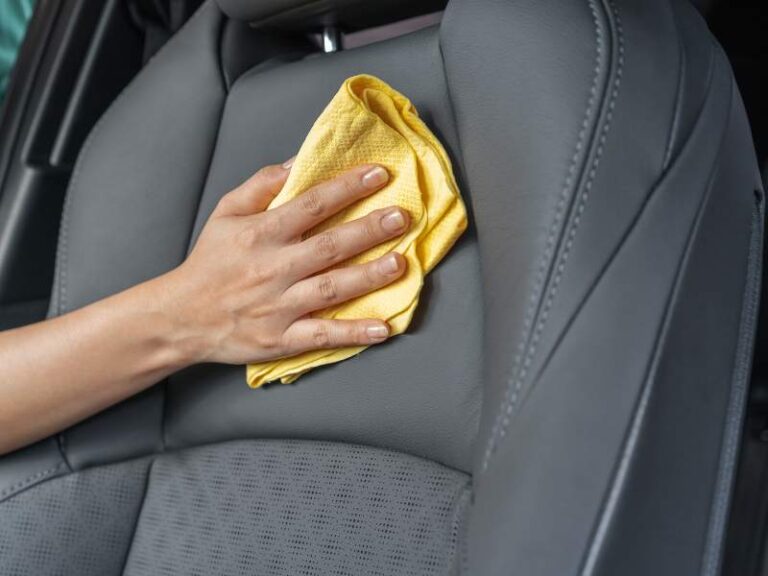Types of Car Seat Covers | How to Select the Best One
Car seat covers are more than just a stylish accessory for your car—they’re essential for protecting your seats from wear and tear while enhancing the comfort and look of your vehicle’s interior. With so many options available, it can feel overwhelming to choose the right seat cover for your needs. Whether you’re looking to safeguard your car seats from spills and dirt, improve driving comfort, or simply upgrade your car’s appearance, picking the right material is key.
In this guide, we’ll explore the various types of car seat covers, offer pros and cons for each, and help you decide which one suits your lifestyle best. We’ll also compare pricing, maintenance, and how to pick seat covers based on climate and your specific needs, like being kid or pet-friendly.
Wait…! In case you don’t have time to read full article jump the desire section from table of content.
Why Car Seat Covers Matter

Car seat covers do more than just make your car look good—they protect your seats from the daily grind of life. Think about the drinks that spill, the sun’s rays that fade the fabric, the muddy paws that jump in after a walk. Seat covers are your car seats’ best friend, shielding them from dirt, damage, and wear. Plus, well-maintained seats can even boost the resale value of your car down the road.
Key Benefits of Car Seat Covers:
- Protection: Keep your car seats looking like new, protecting them from dirt, spills, and the sun’s damaging UV rays.
- Comfort: Add extra cushioning and comfort for longer drives.
- Aesthetics: Customize your car’s interior to reflect your style.
- Resale Value: Protecting your seats can preserve or even increase the resale value of your vehicle.
Exploring the Types of Car Seat Covers
Let’s take a deep dive into the most popular types of car seat covers and their benefits and drawbacks. Knowing these will help you match the right seat cover to your needs.
Leather Seat Covers
Leather is the classic choice for car owners who want a luxurious, high-end look. Leather seat covers are durable, long-lasting, and easy to clean, making them a popular choice for those who don’t mind spending a bit more for quality.
Pros and Cons of Leather Seat Covers
| Pros | Cons |
|---|---|
| Luxurious, premium appearance | Expensive compared to other materials |
| Durable and long-lasting | Can get very hot in summer |
| Easy to wipe clean | Requires regular conditioning to prevent cracking |
| Boosts resale value of the vehicle | Not ideal for extreme hot climates |
Best for: “Luxury car owners, those looking to enhance their vehicle’s aesthetics, and people who prefer a low-maintenance option.”
Fabric Seat Covers
Fabric seat covers are great for those looking for comfort without breaking the bank. Available in a variety of colors and patterns, fabric covers allow for a more personalized look.
Pros and Cons of Fabric Seat Covers
| Pros | Cons |
|---|---|
| Affordable and easy to find | Prone to staining and hard to clean |
| Comfortable and breathable | Less durable than leather |
| Available in many colors and patterns | Can fade with prolonged sun exposure |
| Soft to the touch | May retain moisture in humid environments |
Best for: “Budget-conscious families, daily commuters, and those who like to customize their car’s interior with a variety of designs.”
Neoprene Seat Covers
Neoprene, the material used to make wetsuits, is waterproof, durable, and resistant to both heat and moisture. This makes it perfect for people who live in wet climates or enjoy outdoor activities that could leave their car seats vulnerable to the elements.
Pros and Cons of Neoprene Seat Covers
| Pros | Cons |
|---|---|
| Fully waterproof, great for outdoor use | Limited design options |
| Heat and UV resistant | Can feel a bit stiff or bulky |
| Very durable and long-lasting | Slightly more expensive than fabric covers |
Best for: “Outdoor enthusiasts, families who love adventures, and drivers living in rainy or humid climates.”
Velour Seat Covers
Velour seat covers provide a soft, plush feel that makes driving super comfortable. If you live in a colder climate or just want a more luxurious feel without the cost of leather, velour is a good option.
Pros and Cons of Velour Seat Covers
| Pros | Cons |
|---|---|
| Soft and plush for added comfort | Prone to staining and hard to clean |
| Offers a premium look at a lower price | Not waterproof |
| Adds warmth, perfect for colder climates | Wears down quicker than more durable materials |
Best for: “Drivers who value comfort and elegance, particularly those in colder regions.”
Canvas Seat Covers
Canvas seat covers are built to take a beating. If you use your car for rugged activities or frequently transport pets, kids, or heavy tools, canvas is a great option due to its durability and resistance to dirt and water.
Pros and Cons of Canvas Seat Covers
| Pros | Cons |
|---|---|
| Extremely durable and dirt-resistant | Not as soft or comfortable as other materials |
| Waterproof and great for rugged use | Limited design options, usually in neutral colors |
| Ideal for families with kids or pets | Rougher texture, may not feel luxurious |
Best for: “Truck owners, pet owners, or anyone who needs a heavy-duty solution for a rugged lifestyle.”
Sheepskin Seat Covers
If you’re after the ultimate in comfort, sheepskin covers are your go-to. They offer natural temperature regulation, keeping you cool in the summer and warm in the winter.
Pros and Cons of Sheepskin Seat Covers
| Pros | Cons |
|---|---|
| Naturally regulates temperature | Expensive compared to other materials |
| Luxurious, soft feel | Requires regular maintenance to keep it looking good |
| Adds a unique, premium aesthetic | Not waterproof, so be mindful of spills |
Best for: “Drivers in extreme weather conditions or anyone who wants top-tier comfort and luxury.”
Choosing the Right Seat Cover for Different Weather Conditions

The climate you live in plays a significant role in deciding which seat cover material is right for you. Certain materials handle extreme temperatures better than others, and some offer more comfort in specific conditions.
Hot Climates
If you live in a hot area, opt for materials that stay cool and resist moisture. Neoprene and fabric are your best options because they resist heat buildup. Leather, while luxurious, can get unbearably hot in direct sunlight.
Cold Climates
In colder climates, you’ll want seat covers that keep you warm and cozy. Velour and sheepskin are perfect for these conditions, as they offer warmth and comfort. Leather, on the other hand, can feel chilly in winter.
Wet or Humid Climates
If your area gets a lot of rain or is highly humid, look for waterproof materials like neoprene or canvas. These materials will resist moisture and help prevent mold or mildew from building up.
Comfort vs. Durability: What’s More Important?
When picking a car seat cover, the balance between comfort and durability often comes down to your lifestyle. Do you need something tough to handle daily wear or something comfortable for long drives?
Prioritizing Comfort
If comfort is your top priority, go for sheepskin, velour, or leather. These materials are soft, plush, and offer excellent support for long trips.
Best for: “People who spend a lot of time driving or want a more luxurious experience.”
Prioritizing Durability
If you’re more concerned about protecting your seats from dirt, spills, and damage, canvas, neoprene, or leather are your best bets. These materials are built to last and can handle heavy use.
Best for: “Families with kids, pet owners, or those who need rugged protection for their seats.”
Comparing Leather to Other Materials
Leather is often seen as the top-tier choice for seat covers, but how does it stack up against other materials like fabric or neoprene? Here’s a comparison chart to help you weigh the differences:
| Feature | Leather | Fabric | Neoprene | Canvas | Velour | Sheepskin |
|---|---|---|---|---|---|---|
| Comfort | High | Medium | Medium | Low | High | High |
| Durability | High | Medium | High | High | Low | Medium |
| Water Resistance | Low | Low | High | High | Low | Low |
| Ease of Cleaning | Easy | Difficult | Easy | Easy | Difficult | Difficult |
| Price | High | Low | Medium | Medium | Low | High |
| Best For | Luxury Cars | Daily Drivers | Outdoor Lovers | Rugged Use | Comfort Seekers | Climate Control |
Family-Friendly Seat Cover Materials

For families with young kids, finding a seat cover material that’s both easy to clean and durable is crucial. Kids are prone to spills, and you want to protect your seats without too much hassle.
Best Materials for Families
- Neoprene: It’s waterproof, making it perfect for dealing with spills and messes.
- Canvas: It’s extremely durable and resistant to dirt, so it’s great for families who need something tough.
- Leather: Although pricier, it’s very easy to wipe clean and resists stains from food and drinks.
Worst Materials for Families
- Velour and fabric tend to absorb liquids and are much harder to clean, making them less ideal for families with young children.
Dog-Friendly Seat Covers: What to Look For

If your four-legged friend is a frequent passenger, you need a seat cover that can withstand claws, fur, and the occasional muddy paw print.
Best Materials for Pet Owners
- Neoprene: Its waterproof nature makes it great for resisting dirt and wet fur.
- Canvas: Very tough and resistant to scratches, making it an ideal choice for pet owners.
- Leather: While durable, leather can be scratched, so it may need extra protection or care with pets.
Look for features like anti-slip backing and side flaps to protect your car seats fully and keep the cover in place as your pet moves around.
Enhancing Your Car’s Aesthetic Appeal
Seat covers aren’t just functional—they can also transform your car’s interior. Here’s how different materials fit into various aesthetic goals.
Luxury Look
If you want your car to look sleek and high-end, leather or faux leather seat covers are your best bet. They add sophistication and class to any vehicle.
Sporty and Fun Vibes
For a more playful, sporty look, neoprene or fabric seat covers, especially those in bright colors or bold patterns, can bring energy and personality to your car.
Custom Designs
For those who want something truly unique, custom-fit leather or fabric covers offer the chance to tailor your seat covers to match your car’s specific interior.
Custom Fit vs. Universal Fit Seat Covers
When deciding on seat covers, you’ll need to choose between custom-fit and universal-fit options.
- Universal Fit: These are designed to fit most vehicles and are generally more affordable and easier to install. However, they may not fit as snugly as custom-fit covers.
- Custom Fit: These are tailored to your car’s specific make and model, offering a more seamless look and better protection. While more expensive, they provide the best fit and aesthetic appeal.
Price Comparison: What to Expect
Seat cover prices can vary widely based on the material, brand, and whether they are custom or universal. Here’s a general breakdown:
| Material | Price Range (per set) |
|---|---|
| Leather | $100 – $500 |
| Neoprene | $70 – $300 |
| Fabric | $30 – $150 |
| Canvas | $50 – $200 |
| Velour | $40 – $180 |
| Sheepskin | $150 – $600 |
Leather and sheepskin are on the higher end of the spectrum, but fabric and canvas offer affordable options for budget-conscious shoppers.
Maintenance and Cleaning Tips
Each material requires different care to keep it looking great and lasting long.
- Leather: Wipe it down regularly with a damp cloth and use leather conditioner to prevent cracking and fading.
- Fabric: Vacuum and spot clean to remove dirt and spills. Some fabric covers are machine washable.
- Neoprene: Just wipe with a damp cloth or rinse with water for tougher spills.
- Velour: Regularly vacuum to remove dust and spot clean for stains.
- Sheepskin: Brush regularly and use a wool-specific cleaner to maintain its softness.
Popular Seat Cover Brands for 2024
When choosing your seat covers, it’s smart to go with trusted brands known for quality and durability. Here are some top brands to consider:
- Leather: Katzkin, Coverking.
- Neoprene: Wet Okole, Rough Country.
- Fabric: FH Group, BDK.
- Canvas: Carhartt, Rugged Ridge.
- Sheepskin: Eurow, OxGord.
These brands have proven reputations for producing high-quality car seat covers across various materials and price points.
Trending Seat Cover Designs in 2024
- Sustainable Materials: More and more manufacturers are offering eco-friendly options made from recycled materials.
- Bold Patterns: Bright, vibrant seat covers are trending for those looking to make a statement.
- Luxury Quilted Designs: Quilted leather seat covers with elegant stitching are gaining popularity among luxury car owners.
Final Recommendations: Which Seat Cover Should You Choose?
- For luxury seekers: Go for leather or faux leather for a sleek, sophisticated look.
- For families: Choose neoprene for its waterproof and easy-clean properties.
- For pet owners: Canvas or neoprene will handle the wear and tear from your furry friends.
- For budget-conscious buyers: Fabric seat covers offer great comfort and style without breaking the bank.
Conclusion: Choosing the Right Car Seat Cover
Picking the right car seat cover is all about finding the balance between comfort, durability, and style. Whether you opt for a luxurious leather cover, a waterproof neoprene option, or a budget-friendly fabric solution, your car’s interior will thank you. A good seat cover not only protects your seats but also enhances your driving experience, making every ride a little more enjoyable. Invest in a quality cover today and keep your car looking and feeling its best for years to come.
Frequently Asked Questions (FAQs)
Here are some common questions about car seat covers to help you make an informed decision:
What is the best material for car seat covers in hot climates?
Neoprene and fabric seat covers are ideal for hot climates because they are breathable and resist heat. Leather can become uncomfortably hot in direct sunlight, while neoprene offers the added benefit of being waterproof, which can help manage sweat and moisture.
How do I clean and maintain leather seat covers?
Leather seat covers should be wiped down with a damp cloth regularly. For deeper cleaning, use a leather cleaner and conditioner every few months to prevent cracking and fading. Avoid exposing leather to prolonged sunlight to keep it in good condition.
Are neoprene seat covers really waterproof?
Yes, neoprene seat covers are made from the same material as wetsuits, making them fully waterproof. They are a great choice for those who live in rainy or humid climates, and they also protect your seats from spills, sweat, and moisture.
Can I use seat covers if my car has side airbags?
Many car seat cover brands offer airbag-compatible designs. These covers have special seams that allow the airbags to deploy safely. Always check the product details to ensure the covers are compatible with your car’s airbag system.
What is the best seat cover material for pet owners?
Canvas and neoprene seat covers are the best options for pet owners. Both materials are durable, resistant to scratches, and easy to clean. They also protect your seats from pet hair, dirt, and claws.
Are custom-fit seat covers worth the extra cost?
Custom-fit seat covers are often worth the investment, especially if you want a snug, seamless look for your car’s interior. They offer better protection since they fit perfectly, preventing movement or bunching. They may be more expensive, but they provide the best aesthetic and functional benefits.
How do I choose the right seat cover for my car?
When choosing the right seat cover, consider factors like your budget, climate, lifestyle (e.g., kids or pets), and how much time you’re willing to spend on maintenance. Leather is great for luxury and durability, while neoprene is ideal for waterproof protection. Fabric offers affordability and variety in design.
Can car seat covers affect seat heaters?
Some materials, like leather and neoprene, are thicker and may slightly reduce the effectiveness of seat heaters. However, most high-quality seat covers are designed to work with heated seats. Always check the manufacturer’s guidelines to ensure compatibility.
How long do car seat covers last?
The lifespan of car seat covers depends on the material and how well they are maintained. Leather and neoprene seat covers tend to last the longest—up to 5 to 10 years—if properly cared for. Fabric and velour may wear out sooner, especially with heavy use.
Are there eco-friendly car seat covers available?
Yes, several manufacturers now offer eco-friendly car seat covers made from recycled materials or sustainable fabrics. These covers provide the same protection and aesthetic appeal while reducing environmental impact, making them an excellent choice for environmentally conscious car owners.
- Can I Get in a Taxi Without a Car Seat? - January 26, 2025
- Can I Get Chlamydia From a Toilet Seat? - January 26, 2025
- Can I Get an Uber With a Car Seat? - January 26, 2025





